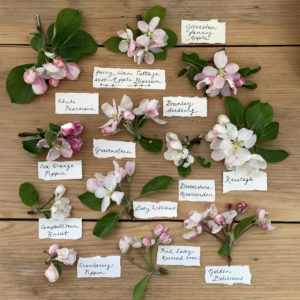
~ Buying Heritage Fruit trees, lessons learnt ~
Mail order:
With heritage fruit tree varities not always in great supply it can at times feel like finding a needle in a haystack. Searching through online catalogues and mail order has at times been the only way for us to source some fruit tree varieties.
The positives:
1. You get the fruit tree varieties that you want, adding diversity to your garden.
2. If you sell your harvest you are adding a variety that a competitor may not sell, less competition on market day.
3. The varieties that you choose may have sentimental value and that adds a richness to your garden reminding you of ancestors, friends and family. I grow Williams apple because it was my Granny’s maiden name, Campbell Russet apple as it’s an ancestral name, Gravenstein apple because I was told fond childhood memories about it, Geeveston Fanny apple because it is a local variety, once exported to the UK in large numbers. but now the variety is hard to find.
4. All great reasons for mail ordering as well as supporting small nurseries that stock these marvellous varieties keeping them alive.
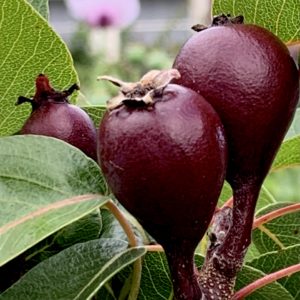
Beurre d’Anjou pears developing on the tree.
The negatives:
1. You are placing your trust and your money in the mail order company and their idea of quality control maybe lacking, while their descriptions maybe wonderful and describe a grown tree they certainly may not describe what is delivered to you. Years ago we received several mail order trees that could barely be called that, more like the tinniest whispy twigs, bent over and poorly shaped, barely resembling an apple tree. Having difficulty knowing how to shape them I asked my friend who had worked in the local orchards for forty plus years to help me. He looked at them for several minutes, shook his head, asked where I got them from and said in a low voice, I think you’ve been taken. Disappointing to say the least.
2. Packaging. We just received a small mail order of four fruit trees, they were poorly wrapped in a garbage bag, bubble wrap and tape. Sent through Australia Post the roots had broken through the bottom of the garbage bag. No wonder, they were so poorly wrapped and we were left with 3/4 bucket of plastic to throw in the bin, none of it compostable. Compostable packaging is important to me and a factor I consider when purchasing something, I just assumed that given the nursery promoted planting fruit trees for a more sustainable future all parts of their business would follow sustainable guidelines eg. compostable packaging.
I am still interested in buying heritage fruit trees using mail order in the future but I will be checking the packaging policy, how the nursery packs them and what they pack them in. My fault for not checking, having purchased bare rooted roses by mail order they arrive in a cardboard box with compostable packaging, I just assumed the nursery would have the same kind of packaging for the bare rooted trees to arrive safely.
I have deliberately not mentioned company names, after all you may have had a better experience with them, I did give one nursery the benefit of the doubt and was a returning customer, after receiving the same service. I won’t return again.
A shout out to all the wonderful nurseries growing and selling healthy fruit trees that help us home gardeners grow fruit for our families. Buying from you is a wonderful experience.
3. It usually takes 3, 4 or 5 years for a tree to start cropping well. Fruit trees are an investment for the future. Some trees are sold as 2 or 3 year old bare rooted trees but just because one variety is advertised as that can mean that the rest of the catalogue is sold as 1 year old bare rooted trees. Make sure you check. I have been caught out with this. It is better to get a 2, 3 or 4 year old bare rooted tree, they are more robust and the nursery (if they have been doing their job properly) have shaped it well for good harvests in the years to come. Gosh it was a sick feeling realising I had spent $35 on a one year old bare rooted fruit tree.
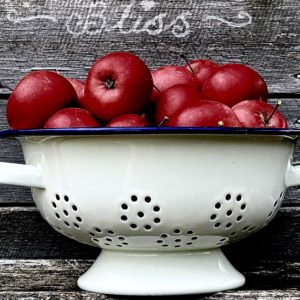
Huon Crabapples.
Lessons Learnt with mail ordering.
Look for recommendations when mail ordering, also read through the comments and how the nursery responds to questions on social media sites. My experience has been that if a nursery take the time to connect with customers and are respectful they don’t take the customer for granted and their trees reflect that by being better quality.
With each bare root tree I order check at what age it is sold.
Check that the packaging is compostable.
Check for customer feedback and recommendations.
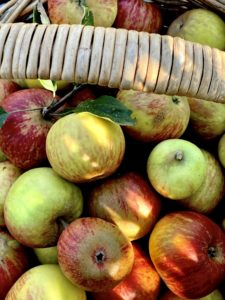
Bramley Seedling apples.
Like I mentioned in the first blog article in this series, it is always great to go into a nursery in person if possible and ask nursery staff if they can order in a specific heritage fruit tree variety if it isn’t in stock, keep in mind when the bare rooted fruit trees hit the nurseries.
I’ve written some other blog articles that maybe of interest, there is:
Why a fruit tree is more than just a fruit tree HERE
Establishing Our Garden: Fruit Trees HERE.
Plus there are more blog articles about the garden at Fairy Wren Cottage in the Wildlife Friendly Gardening category located in the side bar.
Happy Gardening, take precious care,
Jude x
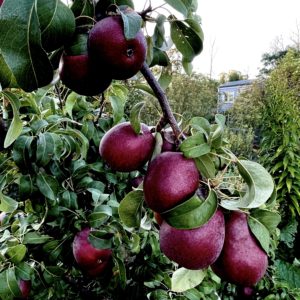
Beurre d’Anjou Pears nearly ready to harvest.
Growing Heritage Fruit Trees. Part III.
September 9, 2021
comments
share